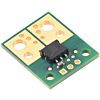ACS72981LLRATR-050U3 Current Sensor Compact Carrier 0A to 50A, 3.3V
Available with a lead time
Expect dispatch between Dec 25 and Dec 29
Quantity Discounts:
- 10+ $21.77 (exc GST)
- 25+ $21.09 (exc GST)
 Large Carrier |
#5270 | 050B3 | 3.0 to 3.6 (3.3 nominal) |
Bidirectional | ±50 A | 26.4 | 1.65 | 1.4"×1.2" |
| #5273 | 100B3 | ±100 A | 13.2 | |||||
| #5277 | 150B3 | ±150 A | 8.8 | |||||
| #5272 | 050U3 | Unidirectional | 0-50 A | 52.8 | 0.33 | |||
| #5275 | 100U3 | 0-100 A | 26.4 | |||||
| #5279 | 150U3 | 0-150 A | 17.6 | |||||
| #5283 | 200U3 | 0-200 A | 13.2 | |||||
| #5271 | 050B5 | 4.5 to 5.5 (5 nominal) |
Bidirectional | ±50 A | 40 | 2.5 | ||
| #5274 | 100B5 | ±100 A | 20 | |||||
| #5278 | 150B5 | ±150 A | 13.3 | |||||
| #5282 | 200B5 | ±200 A | 10 | |||||
| #5276 | 100U5 | Unidirectional | 0-100 A | 40 | 0.5 | |||
| #5280 | 150U5 | 0-150 A | 26.7 | |||||
 Compact Carrier |
#5250 | 050B3 | 3.0 to 3.6 (3.3 nominal) |
Bidirectional | ±50 A | 26.4 | 1.65 | 0.7"×0.8" |
| #5253 | 100B3 | ±100 A | 13.2 | |||||
| #5257 | 150B3 | ±150 A | 8.8 | |||||
| #5252 | 050U3 | Unidirectional | 0-50 A | 52.8 | 0.33 | |||
| #5255 | 100U3 | 0-100 A | 26.4 | |||||
| #5259 | 150U3 | 0-150 A | 17.6 | |||||
| #5263 | 200U3 | 0-200 A | 13.2 | |||||
| #5251 | 050B5 | 4.5 to 5.5 (5 nominal) |
Bidirectional | ±50 A | 40 | 2.5 | ||
| #5254 | 100B5 | ±100 A | 20 | |||||
| #5258 | 150B5 | ±150 A | 13.3 | |||||
| #5262 | 200B5 | ±200 A | 10 | |||||
| #5256 | 100U5 | Unidirectional | 0-100 A | 40 | 0.5 | |||
| #5260 | 150U5 | 0-150 A | 26.7 | |||||
|
This compact carrier features the ACS72981LLRATR-050U3, which is intended for nominal 3.3 V operation and is designed for unidirectional input current from 0 A to 50 A. This version can be visually distinguished from the other versions by the “3V3 U05” printed on the bottom side, as shown in the left picture above.
| Part Suffix | Range | Supply Voltage | Sensitivity @ 3.3 V | Zero Point @ 3.3 V | Size |
|---|---|---|---|---|---|
| 050U3 | 0-50 A (unidirectional) | 3.0 V to 3.6 V | 52.8 mV/A | 0.33 V | 0.7"×0.8" |
A larger carrier is also available for this sensor IC with room for larger connectors and thicker wires for the high-current path, offering different ways to use or evaluate this current sensor.
Using the sensor
 |
This sensor has five required connections: the input current (IP+ and IP-), logic power (VCC and GND), and the sensor output (VIOUT).
The sensor requires a supply voltage of 3.0 V to 3.6 V to be connected across the VCC and GND pads, which are labeled on the bottom silkscreen. The sensor outputs a ratiometric analog voltage on VIOUT that has a zero point at VCC/10 and increases by 52.8 mV × (VCC/3.3 V) per amp of input current:
VIOUT=VCC10+0.0528VA⋅VCC3.3V⋅IP=VCC⋅(110+IP62.5A)" role="presentation" style="position: relative;">VIOUT=VCC10+0.0528VA·VCC3.3V·IP=VCC·(110+IP62.5A)VIOUT=VCC10+0.0528VA·VCC3.3V·IP=VCC·(110+IP62.5A)
IP=62.5A⋅(VIOUTVCC–110)" role="presentation" style="position: relative;">IP=62.5A·(VIOUTVCC–110)IP=62.5A·(VIOUTVCC–110)
The VIOUT, VCC, and GND pins work with 0.1"-pitch header pins and are compatible with standard solderless breadboards.
 |
You can insert the board into your current path in a variety of ways. For typical high-current applications, you can solder wires directly to the through-holes that best match your wires, or you can use solderless ring terminal connectors, as shown in the pictures below. The largest through-holes are big enough for 8 AWG wires or #6 or M3.5 screws, and the second-largest through-holes (and mounting holes) are sized for 12 AWG wires or #2 or M2 screws. Holes with 0.1", 3.5 mm, and 5 mm spacing are also available as shown in the diagram above for connecting male header pins or terminal blocks, but please note that these connection options will generally not be suitable for the kinds of high currents intended for this sensor.
|
|
||
|
Warning: This product is intended for use below 30 V. Working with higher voltages can be extremely dangerous and should only be attempted by qualified individuals with appropriate equipment and experience.
Schematic and dimension diagrams
 |
|
ACS72981 Current Sensor Carrier schematic diagram. |
|---|
The dimension diagram is available as a downloadable PDF (400k pdf).
Real-world power dissipation considerations
 |
|
Thermal image of a high-current test of a Pololu current sensor carrier (not necessarily this product). |
|---|
Depending on the version, the ACS72981 can measure up to ±200 A, but its datasheet specifies an absolute maximum continuous current of 120 A. Furthermore, the sensor chip can overheat at lower currents. In Pololu's tests, Pololu found that Pololu's ACS72981 carrier boards could conduct 60 A continuously while staying well below the thermal limit for the IC. Pololu's tests were conducted at approximately 25°C ambient temperature with no forced air flow.
The actual current you can pass through the sensor will depend on how well you can keep it cool. The carrier’s printed circuit board is designed to help with this by drawing heat out of the sensor chip. Solid connections to the current path pins (such as with thick soldered wires or large, tightly-secured lugs) can also help reduce heat build-up in the sensor and carrier board.
Warning: Exceeding temperature or current limits can cause permanent damage to the sensor. If you are measuring an average continuous current greater than 50 A, Pololu strongly recommend that you monitor the sensor’s temperature and look into additional cooling if necessary.
This product can get hot enough to burn you long before the chip overheats. Take care when handling this product and other components connected to it.
Dimensions
| Size: | 0.7" × 0.8" |
|---|---|
| Weight: | 1.4 g |
General specifications
| Typical operating voltage: | 3.3 V |
|---|---|
| Current sense: | 52.8 mV/A1 |
| Minimum logic voltage: | 3.0 V |
| Maximum logic voltage: | 3.6 V |
| Supply current: | 14 mA2 |
| Current range: | 0A to ?50A (unidirectional 50A), 3.3V |
| Current sensor: | Allegro ACS72981LLRATR-050U3 |
Notes:
Identifying markings
| PCB dev codes: | cs04a |
|---|---|
| Other PCB markings: | 0J14752 |
| Other PCB markings: | 3V3 U05 |
File downloads
-
Dimension diagrams of the ACS72981xLR Current Sensor Carriers (400k pdf)
-
3D model of the ACS72981xLR Current Sensor Compact Carriers (3MB step)
-
Drill guide for the ACS72981xLR Current Sensor Compact Carriers (18k dxf)
This DXF drawing shows the locations of all of the board’s holes.
Recommended links
-
This is the application note referenced on page 16 of the ACS724 datasheet, page 22 of the ACS71240 datasheet, and page 42 of the ACS72981xLR datasheet. The ACS720 is used validate the test methods presented, but these same methods and principles would also apply to the ACS724, ACS71240, and ACS72981.
Exact shipping can be calculated on the view cart page (no login required).
Products that weigh more than 0.5 KG may cost more than what's shown (for example, test equipment, machines, >500mL liquids, etc).
We deliver Australia-wide with these options (depends on the final destination - you can get a quote on the view cart page):
- $3+ for Stamped Mail (typically 10+ business days, not tracked, only available on selected small items)
- $7+ for Standard Post (typically 6+ business days, tracked)
- $11+ for Express Post (typically 2+ business days, tracked)
- Pickup - Free! Only available to customers who live in the Newcastle region (must order online and only pickup after we email to notify you the order is ready). Orders placed after 2PM may not be ready until the following business day.
Non-metro addresses in WA, NT, SA & TAS can take 2+ days in addition to the above information.
Some batteries (such as LiPo) can't be shipped by Air. During checkout, Express Post and International Methods will not be an option if you have that type of battery in your shopping cart.
International Orders - the following rates are for New Zealand and will vary for other countries:
- $12+ for Pack and Track (3+ days, tracked)
- $16+ for Express International (2-5 days, tracked)
If you order lots of gear, the postage amount will increase based on the weight of your order.
Our physical address (here's a PDF which includes other key business details):
40 Aruma Place
Cardiff
NSW, 2285
Australia
Take a look at our customer service page if you have other questions such as "do we do purchase orders" (yes!) or "are prices GST inclusive" (yes they are!). We're here to help - get in touch with us to talk shop.
Have a product question? We're here to help!
Videos
View AllGuides
The Maker Revolution
Getting Hands-on with Sensors
Projects
WhyzaGC - Feather ESP32 addon to the MightyOhm Gieger Counter
Makers love reviews as much as you do, please follow this link to review the products you have purchased.


















Product Comments